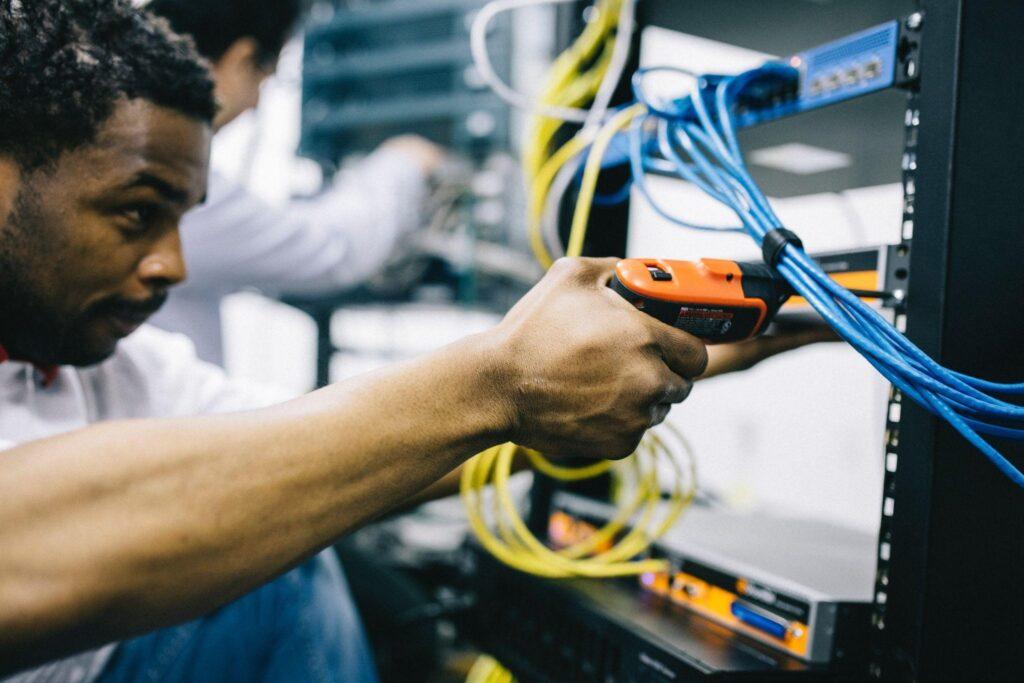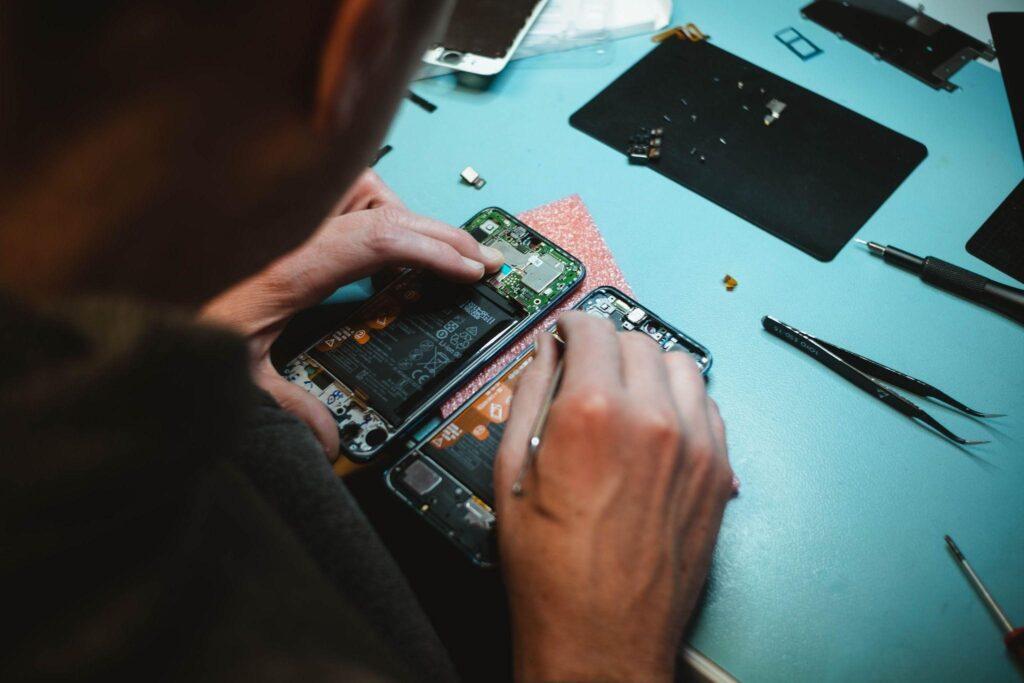
When augmented reality emerged onto the scene, most people anticipated that it would primarily change consumer industries, like gaming. This idea was seemingly confirmed with the explosive popularity of Pokémon Go, the 2016 AR game that saw gamers capture virtual pokemon out in the real world, using only their phone.
But some of the most powerful applications of augmented reality are in industry. One major area that AR promises to upend is the maintenance of physical equipment, which has long been an inefficient and cumbersome process.
To fix hardware – for example, a point-of-sale device in retail – a business would need to deploy an engineer on-site. There are several major issues with regularly deploying a network of engineers for site visits.
Operational inefficiency

Engineers have to travel from site to site, which demands additional business activities. There must be route planning, so that the engineer travels in the most efficient way possible. There must be expense tracking, so that the engineer can be properly reimbursed for any associated travel costs. There may even be additional physical assets, such as a company car, that require their own support. Extensively traveling to different locations, in short, is operationally inefficient.
Opportunity cost

In a perfect world, the stakeholder will wait patiently for the engineer to arrive and fix the issue. But people have grown accustomed to on-demand support. If a device is not immediately fixed, the customer may leave, the client may threaten termination of contract, or the employee may get disgruntled. There is a significant opportunity cost, in short, in regularly leaving devices unfixed while the engineer heads to the location. Businesses lose revenue, brand loyalty, and other markers of value.
Lack of escalation
When a business relies on an army of field engineers to fix problems on site, there is no proper escalation. Any issue, no matter how small or minor, will require an engineer to pack up his bags and head over. Troubleshooting should not be a binary, an all-or-nothing proposition, as it is a significant waste of company resources. IT teams should be able to fix smaller issues remotely if the technology allows, and only travel to a site for more serious issues that absolutely require site presence.

Augmented reality can address these issues and offer additional advantages. In a business setting, AR is usually offered through a solution that integrates it with several complementary technologies. AirDroid, for instance, combines a remote camera with augmented reality, and further enhances customer support through HD voice chat. Having multiple inputs, in this case both audio and video, makes it easy for a customer or colleague to follow what an IT professional is telling them to do. The IT professional can also enter the device into black screen mode if any sensitive information needs to be temporarily hidden.
These fully integrated AR solutions can change physical repair for businesses in several notable ways.
Improve real-time responsiveness and efficiency

Rather than immediately rush to travel on-site, an organization’s domain expert – whether they are an IT professional or other engineer – can remotely view the faulty equipment through an on-site camera. After assessing the situation, the domain expert can make one of two choices: One, he can elect to go on site if the problem is serious enough to merit on-site intervention. Two, he can coach an on-site customer or colleague to fix the problem with his guidance.
The strength of remote support is that most day-to-day issues will fall into the second category, sparing businesses costly trips they would otherwise need to take in the older maintenance paradigm. To help domain experts with these simple repairs, they can place 3D markers onto real world objects. An IT professional could highlight the correct part of the smart TV to unscrew, so their on-site colleague knows where to begin, for example.
The importance of these 3D markers should not be overlooked. While most will see them as mere quality of life upgrades – the domain expert could have verbally described any item in their view for the on-site colleague to locate through trial-and-error, after all – the fact that the 3D markers are visual may help with accuracy.
The 3D markers harken to the Japanese system of shisa kanko, which is a pointing-and-calling system that enhances occupational safety on railways and other industrial sites. In lieu of an index finger, the remote domain experts effectively point with the 3D marker, which helps the on-site colleague find the right part immediately, a crucial need in some repairs where trial-and-error location may be risky.
By guiding colleagues to fix hardware issues with this kind of digital shisa kanko, the device can be returned to service much faster, with no drop-off in quality.
Maximize human capital

With the status quo of sending engineers out into the field, there is enormous unutilized capacity. A small portion of their working hours will be spent on actually fixing machines. The majority of their time will be spent on inconsequential business activities, such as driving to a site, filing reimbursements, and attending to their work vehicle.
This system is not only a drain on company resources, but on the very morale of employees: Instead of concentrating on the skill or trade they spent years learning, they effectively become long-haul drivers who occasionally practice their craft.
Augmented reality can shatter this model. Instead of operating on a one-to-one model of fixing devices, domain experts can now execute a one-to-many model. All the time spent commuting to and from sites can instead be spent remotely guiding their on-site customers or colleagues to successfully repair a device. They can schedule these support sessions one after the other, so as to maximize their previously unutilized capacity. Domain experts accustomed to the old model that had significant downtime may initially be taken aback by this scheduling, but they will be rejuvenated by their productivity: They are now maximizing the skills they dedicated their life to learning.
These remote sessions may be so efficient that domain experts will gain additional downtime. Rather than just providing remote support, they can also contribute to higher-value technology tasks, such as research and development or intellectual property creation. As a whole, AR-aided remote support will transform their workday, condensing repair activities into efficient time blocks and giving them additional room with which to innovate.
Professionalize support operations

The old model of on-site repairs was effectively a black box. A business could only track some operations, such as driving, with a transportation management system. They would know that an engineer spent X amount of time driving from point A to point B. Transparency on-site was non-existent however.
A business could infer how much time was spent on a given site based on when they left for their next assignment, but how much time was spent on the actual repair versus hanging out with on-site staff or other leisure activities was anyone’s guess.
Remote support through augmented reality provides unprecedented transparency into support operations. Because most support calls will be facilitated online – save for the occasional in-person visit for more serious issues – companies gain a treasure trove of data. Most crucially, businesses gain insights into individual usage rates, which can be segmented by day or month.
Such data is even more valuable for businesses that do not only maintain their own devices, but offer their products and services to other companies. These enterprises can provide seat management through their remote support solution, which ensures that clients will pay more as more of their staff consume more service hours. Through session reporting, an organization can track key metrics such as session owner, duration, and connection status. By regularly reviewing session reports, business-to-business companies can optimize workflows to improve retention of clients.
AR-aided remote support enhances an organization’s data practice, unlocking value from what was once a black box in the form of insights, revenue, and growth.
Augmenting your business with AR-aided remote support
In much the same way that the COVID-19 pandemic changed the nature of work, pushing more organizations to adopt hybrid configurations, so, too, will the advent of augmented reality drive a hybrid approach to device management and repair. Instead of always deploying engineers into the field, organizations can only take to this measure as a last resort. Their primary avenue for fixing devices in the field will be remote support aided by augmented reality.
Augmented reality is the perfect technology for remote support. With AR, domain experts can coach on-site colleagues or customers into fixing issues with no decline in support quality. The use of 3D markers will help stakeholders identify key device components or parts, which the domain expert can further explain what to do with via HD voice chat.
While the adoption of AR-aided remote support makes businesses more efficient, its effect on individual workers should not be underestimated. Professionals will appreciate spending more time on their core competencies rather than traveling between work sites. They will also be freer to pursue higher-level tasks in technology or product development.
Upon implementing a remote support solution with AR, businesses gain a wealth of data on their support operations. This information will bring insights that improve their operations, whether in service of their own business or those of clients.
In the end, augmented reality may sound like a futuristic technology, but it is providing real world value to businesses today. Enterprises keen on transforming their hardware support into a source of competitive advantage should turn augmented reality into a business reality.

[…] allows both the service agent and customers to visualize malfunctioning devices and figured out the fastest way to resolve technical issues. With AirDroid Remote Support, IT support agent can place 3D markers while using the AR camera […]
AR-aided remote support enhances an organization’s data practice, unlocking value from what was once a black box in the form of insights, revenue, and growth.
[…] is there on-site, verbally coaching the colleague or customer through the issue. This voice chat is coupled with augmented reality. Through AR, the engineer can place markers on a physical device, so he can direct the on-site […]